Thu 28 Jan 2021
A Movie Review by David Friend: RAFFLES (1939).
Posted by Steve under Mystery plays , Reviews[14] Comments
RAFFLES. United Artists, 1939. David Niven (Raffles), Olivia de Havilland, Dame May Whitty, Dudley Digges, Douglas Walton (Bunny), E. E. Clive. Based upon the celebrated adventures of “The Amateur Cracksman” by E. W. Hornung. Directors: Sam Wood and William Wyler (the latter uncredited).
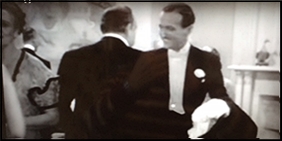
A gentleman jewel thief who routinely baffles Scotland Yard decides to retire. This is because the thief – really A.J. Raffles, famous cricketer – has fallen in love with a girl called Gwen and has vowed to end his career of safe-cracking. However, when his friend Bunny is unable to pay off his debts, Raffles decides to help by stealing Lady Melrose’s necklace. He manages to wangle an invitation to a weekend party she is hosting at her estate and anticipates an easy success. However, Inspector McKenzie attends the party to prevent the theft and another burglary is set to go down the same night…
Today, we’re in an era of Hollywood studios remaking films which aren’t yet twenty years old. Well, this one certainly kicks them to the curb. This is a remake of a nine-year old film from the same country, same studio, same director and same script. And, as David Niven replaces Ronald Colman, it could even have the same moustache too. But, this isn’t a criticism. For one thing, in 1939, they didn’t have DVDs (imagine!), so it had been nearly a decade since people had seen the first film. Also, this has David Niven. Also, this has David Niven. Also, this has … well, it does.
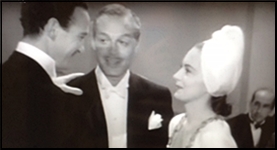
Niven was born to play the role, and it’s a shame that he didn’t make a bigger splash with it. This could easily have been a series, like the Universal set of Sherlock Holmes films with Basil Rathbone. Of course, the war happened and Niven, quite honourably, left Hollywood to fight. And maybe the idea would have been redundant, as this was the same year in which the Saint movies started.
With his easy charm and suavity, Niven is the best thing about this version. The plot is solid and – though set in a house for most of its run-time – features much of the cosily exciting wandering-around-the-house-at-night stuff that I love so much. It heads towards farce, at points, but you won’t read me complaining about that, as it’s all so lightly amusing and even quickens the pulse at times.
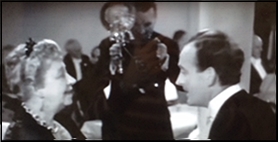
Dame May Whitty (she of The Lady Vanishes – surely one of the best films in the history of moving pictures) plays the dowager-type part of Lady Melrose and there’s some mild comedy to be enjoyed with her oafish aristocratic husband who is straight out of a Blandings novel.
The whole thing about giving Raffles a love-interest is non-canonical, as that never happened in the original stories by E.W. Hornung (brother-in-law of Arthur Conan Doyle). In fact, Raffles himself is softer here than he is supposed to be and Bunny’s suicide pledge is only alluded to, while it was properly depicted in the story which inspired it.
At this point, the character had enjoyed a renaissance of sorts in the British pulp magazine The Thriller, with stories written by Barry Perowne, in which the character was updated to the ’30s. This film is also set in those times (though, confusingly, there’s a scene in a Victorian hansom cab) and there’s even a television, before the invention was really popular.
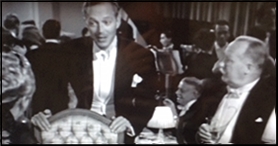
Unfortunately, this spirited film is marred by a hasty ending which, jarringly, tries to include a daring escape, a Golden Age of Hollywood romantic ending and the obligatory reminder that crime does not pay.
The character would again find success in a 1977 television series for ITV with Anthony Valentine in the role. A one-off adaptation, titled The Gentleman Thief, was aired in 2001 and starred Nigel Havers. It was a role he was surely also born to play but, unfortunately, was not followed up on, and hasn’t even had a DVD release. Considering the original books are still in print and remain classics of the genre, it would be great to see them adapted again at some point.
Rating: ***
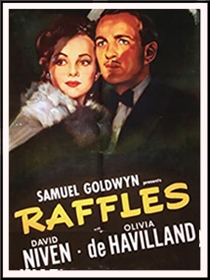
January 28th, 2021 at 3:59 pm
I watched this not too long ago. I didn’t like how Raffles secret was revealed to law enforcement (hard to have a sequel), nor did I like Bunny’s role of not being an accomplice. I did like the ambiguous ending – did Raffles give him self up or escape?
January 28th, 2021 at 4:42 pm
A new version could capitalize on the considerable homoerotic tension between Raffles and Bunny, who at the end of the first published story says:
“I’ll do it again…I will…I’ll lend you a hand as often as you like! What does it matter now? I’ve been in it once. I’ll be in it again. I’ve gone to the devil anyhow. I can’t go back, and wouldn’t if I could. Nothing matters another rap! When you want me I’m your man.â€
If no sexual interpretation occurs to you while you are reading that, you have a cleaner mind than mine.
January 28th, 2021 at 5:07 pm
Re. Raffles on film. Not so long ago I ran the Niven version, following the Coan version, and while preferring Niven’s take and the overall approach, the two silent films, the first with John Barrymore, and the second, even more, likeable with House Peters, worked just fine. As for Anthony Valentine, that young man brought life to the character as well s charm and humor. The version I would have loved, in my mind’s eye, was the proposed but never produced series with George Brent and Nigel Bruce. Bruce died, and that may have caused the everyone folding.
January 28th, 2021 at 5:10 pm
According to Andrew Sarris, Warner Beos re-made movies so often, that the script department was known as the Echo Chamber.
January 28th, 2021 at 5:41 pm
Andrew Sarris seemed informed and analytical at the level of casual conversation. Have a look at The American cinema. Fun while sitting on the pot, but without depth or much meaning. I’ve just opened the book at page 264. Arch Oboler. …came to Hollywood out of the radio tube but never showed the visual flair of Orson Welles. No kidding.
January 28th, 2021 at 6:04 pm
In fact, Graham Greene did see the homoerotic tension between Raffles and Bunny and wrote a play, The Return of A. J. Raffles, about them.
In Hornung’s original stories Raffles is betrayed by a woman spurned, which raises questions about why he spurned her.
January 28th, 2021 at 9:54 pm
I agree the Niven version does have a few points on the Colman take, if only because talkies were a good deal more advanced and comfortable then, and of course Olivia de Haviland. Just as a note when Niven first started in Hollywood he lived in Colman’s beach house at the generosity of the Colmans.
The Barrymore is much closer to Hornung and Raffles nature in the books, and features some extraordinary outdoor stunts by JB himself. Alas I have never seen the Peters verison.
The Valentine version is fine. There was also an appearance by Raffles in one of the Chris Lee/Patrick McNee Holmes films.
While Raffles has no romantic attachment in the stories themselves he does have one off screen so to speak. After the first set of stories Raffles escapes from a ship at sea leaving Bunny to go to prison. While Bunny serves his time Raffles has a romance in Italy that ends tragically and has the Mafia after him. When he returns in the next set of stories he appears a much older man and sets up shop again, but not as Raffles the cricketeer from before, that set of stories ending with his heroic death in the Boer War (brilliantly got around by Barry Perowne in his second period Raffles series and totally ignored in his first updated series for the British pulps).
I have always found the modern take of Raffles and Bunny’s relationship as homoerotic as specious as the suggestion about Holmes and Watson. Victorian male friendships were expressed in flowery ways that to modern ears sound quite different than they did to the individuals then. There is no evidence Conan Doyle or Hornung would have had any reason to be suggesting that.
I have no problem with reinterpreting, as Graham Greene did or Billy Wilder kidded about with Holmes and Watson, only with modern readers so ignorant of the past they can’t tell the difference. The running joke that everyone thinks Holmes and Watson are gay in SHERLOCK is a wry comment on the difference in the times.
It’s a bit like the endless fan fiction suggesting Capt. Kirk and Spock, or Horatio Hornblower and Lt. Bush are gay, it’s fun and empowering for people who for too long had no empowered voice in popular entertainment, but it mustn’t be confused with the reality expressed by those characters creators. Hornblower for instance is second only to James Bond in the number of his romantic conquests.
Any modern interpretation of what Hornung was writing is flawed to begin with because Hornung was not a modern man or writer and did not come from the same cultural background as we do. Nor was he an upper class public schoolboy so that whole interpretation of Raffles and Bunny comes from the outside.
James Bond is a chavinist today, Mike Hammer a Neanderthal, and Travis McGee a practically a stalker, but they were not when they were created in the eyes of the writer or their audience anymore than Bulldog Drummond’s racism and xenophobia was seen as racist or xenophobic in 1920 England.
It is one thing to recognize and decry those things, and another to assume that the writers or their audience at the time perceived them. It is tricky enough to deal critically with what the writers actually consciously or unconsciously were saying without attributing things that simply weren’t there to their work.
Modern interpretation of literature is a tricky thing for even the best critics. Admittedly classics become classics because soemthing in them speaks to later generations, but finding that and attributing it to the intent of the original are two distinct things. I’m pretty certain Jane Austen would be horrified at some of the modern interpretation of her work even though it is legitimate to find that in any lasting work of fiction.
January 28th, 2021 at 11:05 pm
Well written, as usual David, but more importantly, well reasoned and observed.
January 28th, 2021 at 11:32 pm
+1
@ msg #7 above. Thunderously good ruminating. Worth forwarding on to one’s friends.
Regarding the remakes in the 20s, 30s, and 40s. I don’t feel they’re the same detestable menace as are the re-makes of today. How can one really curl one’s lip at an early Hollywood studio which stooped to ‘merely remake’ a film, when the first time out the flick might have been a silent and by the second time around, talkies had arrived? Or some other innovation? Whole new medium. That’s not the case here with Raffles but just to delineate the principle which I think applies. In a time when it was all brand new –and all evolving so rapidly –I’ll excuse them for re-makes.
January 29th, 2021 at 1:00 am
I find David’s comment about being wary of re-interpreting the past in a modern context spot on. There are obviously some things that are hard to ignore, like classifying people as subhuman to make it easier on your own conscience while exploiting them; but finding subtext in the classics is fraught with pitfalls.
If you were to come across a novel set in India with men holding hands, you might well suspect subtext. But it is accepted behavior between male friends. More here. The past is another culture, they do things differently there, to paraphrase L.P. Hartley.
January 29th, 2021 at 5:40 am
Fascinating, David Vineyard, but I think you overstate Hornblower’s conquests: only three, I think, and two he married.
The other interesting aspect of Raffles is his status as both a gentleman and a cricketer. George Orwell pointed out that the fact he is a man-about-town is important – a man-about-town who has gone to prison is merely a man, whereas a baronet who has gone to prison is still a baronet.
Raffles is only socially accepted because he is a cricketer and he feels justified in taking revenge because of that. As Orwell also pointed out, cricket is a game where the distinction between professional and amateur is very wide and very hypocritical – Raffles may be an “amateur cracksman”, but he goes about it professionally and lives off his thefts, just as an amateur cricketer was entitled to claim more in expenses than a professional was paid. An incident recounted by the professional Fred Root sums the difference between amateur and professional cricketers up: Root could run out either of two batsmen who had collided with each other while taking a run, but didn’t as they both seemed injured. An amateur repeatedly shouted “Break the wicket, Fred, break the wicket!†until Root said: “If you want to run him out, here’s the ball: you come and do it.†The amateur answered “Oh, I’m an amateur. I can’t do such a thing.â€
Finally, the fact that Raffles is a slow bowler is important. A slow bowler gets batsmen out by skill and legerdemain. He will fool a batsman by bowling almost identical balls to him, the first intended to be scored from and a later one to get him out. In short, both on the pitch and off, Raffles is a master at imposture.
January 29th, 2021 at 8:34 pm
There are three in the trilogy alone, and one of them he nearly has a tryst with after his marriage to Lady Barbara.
At one point Hornblower is more than a bit chagrined by recalling his wife had commented he would always be a man women were attracted to and it was mutual. He may not have as many conquests as 007, but he is far from gay. Despite that I have no problem with the Fan Fic, only when it is assumed the original creation was about something it was never meant to suggest. Batman and Robin weren’t intended to be gay either.
January 29th, 2021 at 8:45 pm
The homoerotic subtext of the Raffles stories has been commented on for decades, it’s not like I just made it up. Hornung was friendly with Oscar Wilde and Lord Alfred Douglas, and is said to have based his duo partly on them. Another Raffles prototype was his friend George Ives, “a Cambridge-educated criminologist and talented cricketer…privately homosexualâ€.
January 29th, 2021 at 8:59 pm
At which point, I have decided to end the discussion. This is a topic that could go on forever, but it’s my sense that it’s not one that needs to take place here. Apologies in advance if I’ve closed the door before everyone’s had their say.